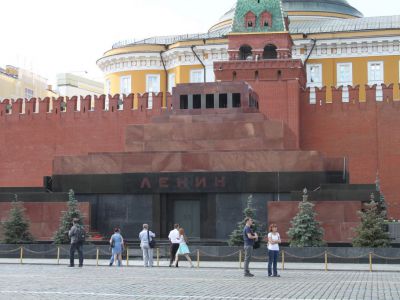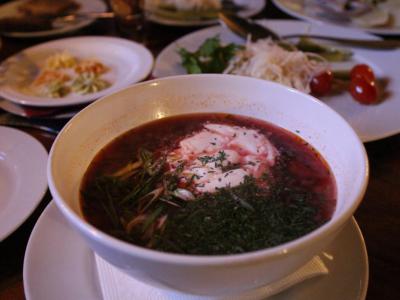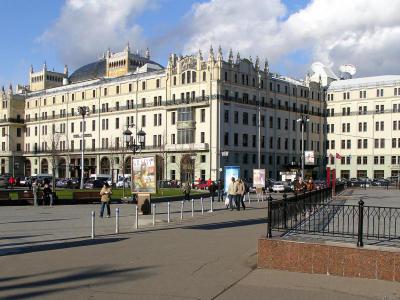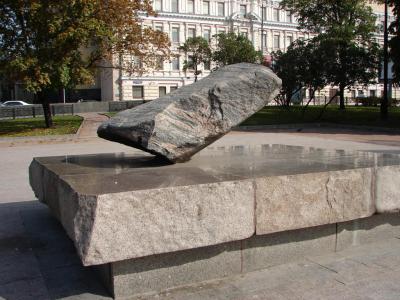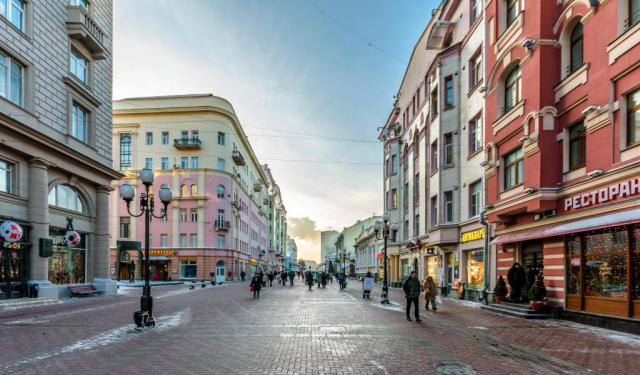
Communist Moscow Tour (Self Guided), Moscow
The arrival of communist ideology left an indelible imprint in the history of the 20th century, largely affecting the lives of people, arts, and architecture. Having been at the heart of the Soviet empire for almost 70 years, Moscow is a great destination for everyone interested in the Soviet heritage, the traces of which are found throughout the city.
By far, the most iconic site associated with the communist legacy in Russia is Lenin's Mausoleum. Situated in Red Square, the mausoleum houses the embalmed body of Vladimir Lenin, the founding father of the Soviet Union.
Canteen #57 (Stolovaya #57) is another historically significant spot. Located within GUM, a famous shopping mall overlooking Red Square, this canteen was a popular dining spot during the Soviet era. It provides a glimpse into the culinary culture of that time, offering traditional Soviet dishes and a nostalgic atmosphere.
The Moscow Metro, especially Revolution Square Station constructed in the 1930s, is a testament to Soviet engineering and design. Known for its grand architecture and ornate decorations, the metro system was a symbol of Soviet progress and efficiency.
Revolution Square and Lubyanka Square are central locations in Moscow that hold their share of the Soviet legacy manifested in various man-made objects and events that took place there, marking pivotal moments in Soviet history.
The Solovetsky Stone, located in Lubyanka Square, is a memorial dedicated to the victims of political repression under Stalin's rule. It serves as a somber reminder of the darker aspects of the communist regime.
The Lubyanka Building, adjacent to Lubyanka Square, was once the notorious headquarters of the KGB, the Soviet Union's state security service. It has a dark history of political persecution during the communist era.
Indeed, Moscow offers a wealth of communist heritage sites that provide insight into Russia's complex history. Exploring these locations allows us to reflect on the ideals of communism and its consequences. To fully appreciate their significance and gain a deeper understanding of the impact of communism on Russia and the world, we encourage you to take this self-guided walk.
By far, the most iconic site associated with the communist legacy in Russia is Lenin's Mausoleum. Situated in Red Square, the mausoleum houses the embalmed body of Vladimir Lenin, the founding father of the Soviet Union.
Canteen #57 (Stolovaya #57) is another historically significant spot. Located within GUM, a famous shopping mall overlooking Red Square, this canteen was a popular dining spot during the Soviet era. It provides a glimpse into the culinary culture of that time, offering traditional Soviet dishes and a nostalgic atmosphere.
The Moscow Metro, especially Revolution Square Station constructed in the 1930s, is a testament to Soviet engineering and design. Known for its grand architecture and ornate decorations, the metro system was a symbol of Soviet progress and efficiency.
Revolution Square and Lubyanka Square are central locations in Moscow that hold their share of the Soviet legacy manifested in various man-made objects and events that took place there, marking pivotal moments in Soviet history.
The Solovetsky Stone, located in Lubyanka Square, is a memorial dedicated to the victims of political repression under Stalin's rule. It serves as a somber reminder of the darker aspects of the communist regime.
The Lubyanka Building, adjacent to Lubyanka Square, was once the notorious headquarters of the KGB, the Soviet Union's state security service. It has a dark history of political persecution during the communist era.
Indeed, Moscow offers a wealth of communist heritage sites that provide insight into Russia's complex history. Exploring these locations allows us to reflect on the ideals of communism and its consequences. To fully appreciate their significance and gain a deeper understanding of the impact of communism on Russia and the world, we encourage you to take this self-guided walk.
How it works: Download the app "GPSmyCity: Walks in 1K+ Cities" from Apple App Store or Google Play Store to your mobile phone or tablet. The app turns your mobile device into a personal tour guide and its built-in GPS navigation functions guide you from one tour stop to next. The app works offline, so no data plan is needed when traveling abroad.
Communist Moscow Tour Map
Guide Name: Communist Moscow Tour
Guide Location: Russia » Moscow (See other walking tours in Moscow)
Guide Type: Self-guided Walking Tour (Sightseeing)
# of Attractions: 7
Tour Duration: 1 Hour(s)
Travel Distance: 2.1 Km or 1.3 Miles
Author: audrey
Sight(s) Featured in This Guide:
Guide Location: Russia » Moscow (See other walking tours in Moscow)
Guide Type: Self-guided Walking Tour (Sightseeing)
# of Attractions: 7
Tour Duration: 1 Hour(s)
Travel Distance: 2.1 Km or 1.3 Miles
Author: audrey
Sight(s) Featured in This Guide:
- Lenin's Mausoleum
- Canteen №57 (Stolovaya №57)
- Moscow Metro: Revolution Square Station
- Revolution Square
- Lubyanka Square
- Solovetsky Stone
- Lubyanka Building
1) Lenin's Mausoleum (must see)
The Red Square Mausoleum is the final resting place of Vladimir Lenin, the illustrious leader of the Russian Revolution and the founder of the Soviet state. Lenin died on January 21, 1924, aged 53. Despite his expressed will to be buried alongside his mother in St. Petersburg, the overall public sentiment suggested that a simple burial would not be enough.
In response to thousands of appeals urging to preserve Lenin’s memory for future generations, Stalin pushed for the decision to embalm his body and the government began the task of constructing a proper tomb for it. The marble and granite mausoleum, replacing a temporary wooden one, was designed by Alexey Shchusev and completed in 1930.
Here Lenin’s body has been on display ever since, with rare exceptions during wartime in the 1940s when it was evacuated to Siberia. Over the decades, it has been one of the main tourist attractions in Moscow, visited by tens of millions of people.
Contrary to the rumors about a “wax mummy” being on display, it is in fact Lenin that you see. A special and complicated embalming process helps to keep the body presentable to the public. An interesting side note about the tomb is that Joseph Stalin was briefly interred there beside Lenin until the government removed it and buried in the Kremlin Wall Necropolis during the de-Stalinization campaign in the 1960s.
No photography, video or audio recording of any sort is allowed inside the mausoleum. All visitors are searched prior to entering and are obliged to show respect during the visit: no talking, smoking, hands in pockets, or wearing hats (except for females).
Why You Should Visit:
A glimpse of the historic figure, if only for a minute or so!
Tip:
Remember to keep moving – you won't be there to stop and stare.
The entrance is free.
In response to thousands of appeals urging to preserve Lenin’s memory for future generations, Stalin pushed for the decision to embalm his body and the government began the task of constructing a proper tomb for it. The marble and granite mausoleum, replacing a temporary wooden one, was designed by Alexey Shchusev and completed in 1930.
Here Lenin’s body has been on display ever since, with rare exceptions during wartime in the 1940s when it was evacuated to Siberia. Over the decades, it has been one of the main tourist attractions in Moscow, visited by tens of millions of people.
Contrary to the rumors about a “wax mummy” being on display, it is in fact Lenin that you see. A special and complicated embalming process helps to keep the body presentable to the public. An interesting side note about the tomb is that Joseph Stalin was briefly interred there beside Lenin until the government removed it and buried in the Kremlin Wall Necropolis during the de-Stalinization campaign in the 1960s.
No photography, video or audio recording of any sort is allowed inside the mausoleum. All visitors are searched prior to entering and are obliged to show respect during the visit: no talking, smoking, hands in pockets, or wearing hats (except for females).
Why You Should Visit:
A glimpse of the historic figure, if only for a minute or so!
Tip:
Remember to keep moving – you won't be there to stop and stare.
The entrance is free.
2) Canteen №57 (Stolovaya №57)
When it's time take a break from sightseeing in Moscow, you may wish to do so as the Muscovites do or least used to in their not-so-distant past. If a nice cup of tea with a sausage roll or the famous rum ball cake, or perhaps something more substantial, sounds like suitable snack arrangement to you, consider popping in to Canteen №57 on the second floor of GUM shopping mall.
While there's no shortage of eateries in the vicinity of Red Square, finding a decent meal at affordable price here can be rather challenging. In this respect, the Soviet-style “Stolovaya” (Canteen) №57 is a real deal: both in terms of cheapness and authenticity of Russian dishes on the menu.
The interior design of this self-service outlet reflects the ambiance of the late Soviet era, with tableware and tablecloths reminiscent of the days gone by. Locals fancy this joint for the quality traditional food, nostalgic atmosphere and low prices, which in turn is a good sign for those foreigners seeking “real MacCoy”.
A huge dining hall offers plenty of comfortable seating. But be prepared to stand a long line though, which is also part of the Soviet practice that will spice up your dinning experience, but only a little, since the line moves quickly. Also, mind the local rule – "Bus your table after meal!" – steadfastly proclaimed by the wall posters.
While there's no shortage of eateries in the vicinity of Red Square, finding a decent meal at affordable price here can be rather challenging. In this respect, the Soviet-style “Stolovaya” (Canteen) №57 is a real deal: both in terms of cheapness and authenticity of Russian dishes on the menu.
The interior design of this self-service outlet reflects the ambiance of the late Soviet era, with tableware and tablecloths reminiscent of the days gone by. Locals fancy this joint for the quality traditional food, nostalgic atmosphere and low prices, which in turn is a good sign for those foreigners seeking “real MacCoy”.
A huge dining hall offers plenty of comfortable seating. But be prepared to stand a long line though, which is also part of the Soviet practice that will spice up your dinning experience, but only a little, since the line moves quickly. Also, mind the local rule – "Bus your table after meal!" – steadfastly proclaimed by the wall posters.
3) Moscow Metro: Revolution Square Station (must see)
The Revolution Square subway station (Russian: Ploshchad Revolyutsii) is one of the oldest on the Moscow Metro network. It opened in 1938, designed by Soviet architect Alexey Dushkin, featuring red and yellow marble arches resting on low pylons faced with black Armenian marble.
The most eye-catching element of the decoration is the 76 bronze statues depicting people of the Soviet Union: soldiers, farmers, athletes, writers, aviators, industrial workers, and schoolchildren – created in the style of socialist realism. The sculptures are grouped in 10 pairs replicated four times throughout the station, flanking the archways and two platforms.
The pairs are placed in a certain order, symbolizing Russia's transformation from the pre-revolutionary past, through the revolution, into the post-revolutionary present, and are as follows:
Male worker-partisan & soldier
Male agricultural laborer & sailor with pistol
Male sailor & female aviator
Male frontier guard with a dog & female sharpshooter
Male miner & engineer
Male & female agricultural laborers
Male & female students
Male football player & female athlete
Mother & father in swim clothing
Male & female students in Young Pioneer uniforms
Local folklore has it that some of the sculptures bring good luck, if rubbed. This concerns specific parts of the sculptures, such as the sailor's pistol, the patrolman's dog's nose, the roosters, and the female student's shoe. Numerous passengers touch or rub the statues as they pass, thus giving their bronze a permanent shine.
Why You Should Visit:
Among many nice metro stations in Moscow, this is one of the most beautiful – makes your feel like you're in a museum or in palace hallways!
Tip:
Amateur photography is allowed, but professional photography requires a special permit from the metro authorities.
To see the station in its full splendor, you need to have a valid ticket. If you intend to get in and out without traveling, consider the minimal possible option, which is a one-way ticket worth under $1.
The most eye-catching element of the decoration is the 76 bronze statues depicting people of the Soviet Union: soldiers, farmers, athletes, writers, aviators, industrial workers, and schoolchildren – created in the style of socialist realism. The sculptures are grouped in 10 pairs replicated four times throughout the station, flanking the archways and two platforms.
The pairs are placed in a certain order, symbolizing Russia's transformation from the pre-revolutionary past, through the revolution, into the post-revolutionary present, and are as follows:
Male worker-partisan & soldier
Male agricultural laborer & sailor with pistol
Male sailor & female aviator
Male frontier guard with a dog & female sharpshooter
Male miner & engineer
Male & female agricultural laborers
Male & female students
Male football player & female athlete
Mother & father in swim clothing
Male & female students in Young Pioneer uniforms
Local folklore has it that some of the sculptures bring good luck, if rubbed. This concerns specific parts of the sculptures, such as the sailor's pistol, the patrolman's dog's nose, the roosters, and the female student's shoe. Numerous passengers touch or rub the statues as they pass, thus giving their bronze a permanent shine.
Why You Should Visit:
Among many nice metro stations in Moscow, this is one of the most beautiful – makes your feel like you're in a museum or in palace hallways!
Tip:
Amateur photography is allowed, but professional photography requires a special permit from the metro authorities.
To see the station in its full splendor, you need to have a valid ticket. If you intend to get in and out without traveling, consider the minimal possible option, which is a one-way ticket worth under $1.
Sight description based on Wikipedia.
4) Revolution Square
Shaped as an arc extended from the southwest to the north, Revolution Square (Russian: 'Ploshchad Revolyutsii') is a historic place in downtown Moscow. Its current name reflects the role that the square once played as a gathering spot during the Socialist Revolution of 1917.
Fully pedestrian nowadays, it is surrounded with monumental architecture dominated by the vast, red-brick building of Moscow City Hall. The latter was constructed in 1890, featuring Russian Revivalist style, and originally housed the ruling Duma disbanded by Bolsheviks after the Revolution. For many years after WWII, the edifice was home to the Lenin Museum.
Another notable façade overlooking the square is indeed that of the majestic Hotel Metropol, one of the finest Art Nouveau creations adorning the city, completed in 1907.
On the north side, the square is curbed by the Hotel Moskva, originally built between 1932 and 1938 by Alexey Shchusev. Despite being regarded as an architectural monument, the hotel was demolished in 2004 and then replicated ten years later, accurately as possible to the original, fitted with underground parking and few other features not available in the 1930s. The new hotel, re-branded as Four Seasons, retains the appearance of its iconic predecessor.
Why You Should Visit:
Impressive historical architecture plus other curious sites, such as the Karl Marx monument and the Vitali Fountain.
Also, check out the zero mile marker from which all the distances to/from Moscow are measured.
Perhaps not a prime destination, but still worth a visit if you're in the area.
Fully pedestrian nowadays, it is surrounded with monumental architecture dominated by the vast, red-brick building of Moscow City Hall. The latter was constructed in 1890, featuring Russian Revivalist style, and originally housed the ruling Duma disbanded by Bolsheviks after the Revolution. For many years after WWII, the edifice was home to the Lenin Museum.
Another notable façade overlooking the square is indeed that of the majestic Hotel Metropol, one of the finest Art Nouveau creations adorning the city, completed in 1907.
On the north side, the square is curbed by the Hotel Moskva, originally built between 1932 and 1938 by Alexey Shchusev. Despite being regarded as an architectural monument, the hotel was demolished in 2004 and then replicated ten years later, accurately as possible to the original, fitted with underground parking and few other features not available in the 1930s. The new hotel, re-branded as Four Seasons, retains the appearance of its iconic predecessor.
Why You Should Visit:
Impressive historical architecture plus other curious sites, such as the Karl Marx monument and the Vitali Fountain.
Also, check out the zero mile marker from which all the distances to/from Moscow are measured.
Perhaps not a prime destination, but still worth a visit if you're in the area.
5) Lubyanka Square
In recent history, Lubyanskaya Square (Russian: Lubyanskaya ploshchad) or simply Lubyanka, has been one of, if not the, most notorious locations in Moscow, largely associated with the presence of the infamous headquarters of the Soviet secret service in its various incarnations: Cheka, OGPU, NKVD, MGB, KGB, and lately FSB.
The first historical records of Lubyanka date back to 1480, when Tsar Ivan III, having conquered Novgorod in 1471, settled many Novgorodians in this part of Moscow who then called the area Lubyanka after the Lubyanitsy district in their home town.
After the Revolution, the square was renamed and for many years (from 1926 to 1990) went by as Dzerzhinsky Square in honor of the founder of the Soviet security force Felix Dzerzhinsky. The monumental Lubyanka building was constructed in 1897-1898 and originally intended to house an insurance company. In 1918, the Bolsheviks seized it to accommodate the newly-established Cheka.
In 1958, the fountain at the center of Lubyanka Square was replaced by an 11-ton statue of Felix Dzerzhinsky ("Iron Felix"). In 1991, the statue was removed by liberal protesters following the failed coup against Mikhail Gorbachev, upon which the square's original name was officially restored.
Opposite the FSB building stands the massive Detsky Mir ("Children's World"), Europe's largest children's store. Built between 1953 and 1957, it was fully restored in 2014. There, inside the main atrium you will find the world's largest mechanical clock, Raketa Monumental.
The first historical records of Lubyanka date back to 1480, when Tsar Ivan III, having conquered Novgorod in 1471, settled many Novgorodians in this part of Moscow who then called the area Lubyanka after the Lubyanitsy district in their home town.
After the Revolution, the square was renamed and for many years (from 1926 to 1990) went by as Dzerzhinsky Square in honor of the founder of the Soviet security force Felix Dzerzhinsky. The monumental Lubyanka building was constructed in 1897-1898 and originally intended to house an insurance company. In 1918, the Bolsheviks seized it to accommodate the newly-established Cheka.
In 1958, the fountain at the center of Lubyanka Square was replaced by an 11-ton statue of Felix Dzerzhinsky ("Iron Felix"). In 1991, the statue was removed by liberal protesters following the failed coup against Mikhail Gorbachev, upon which the square's original name was officially restored.
Opposite the FSB building stands the massive Detsky Mir ("Children's World"), Europe's largest children's store. Built between 1953 and 1957, it was fully restored in 2014. There, inside the main atrium you will find the world's largest mechanical clock, Raketa Monumental.
Sight description based on Wikipedia.
6) Solovetsky Stone
The Solovetsky Stone is a huge granite boulder set in the middle of Lubyanka Square to commemorate political prisoners and victims of political repression in the Soviet Union. The stone originates from the Solovetsky archipelago in the White Sea, commonly known as Solovki, which is the former location of the infamous prison camp, part of the Gulag system, where thousands of people met their end in the 1920s-50s.
The placement of the Stone – outside the KGB headquarters, previously occupied by the monument of Felix Dzerzhinsky, founder of the Soviet secret service – is symbolic and was preceded by great logistical effort. First it was shipped by sea and then carried by rail from the Big Solovetsky Island to Arkhangelsk, and from there to Moscow. Originally, the Stone was placed in a park near the Polytechnic Museum on Lubyanka Square in 1990 by activists in a bid to establish the Day of Remembrance of the Victims of Political Repressions in the USSR (now officially celebrated). Later, it was moved to take the spot of the "Iron Felix" dismantled in 1991.
The Solovetsky Stone is one of the first and perhaps the most important monument of its kind in the former USSR. The inscription at the foot of the pedestal reads: "This stone is delivered by the "Memorial" society members from the Solovki Special Camp and established in memory of the victims of the totalitarian regime."
The memorial was inaugurated on October 30, 1990, the day previously observed unofficially since 1974 as the day of solidarity and resistance – often by way of riots and hunger strikes held in the prison camps. Ever since 2007, each year on the eve of October 30 people gather at the Stone to read out names of the Muscovites executed during the Great Terror years. The Solovetsky Stone is also one of the traditional places in Moscow to voice protest.
The placement of the Stone – outside the KGB headquarters, previously occupied by the monument of Felix Dzerzhinsky, founder of the Soviet secret service – is symbolic and was preceded by great logistical effort. First it was shipped by sea and then carried by rail from the Big Solovetsky Island to Arkhangelsk, and from there to Moscow. Originally, the Stone was placed in a park near the Polytechnic Museum on Lubyanka Square in 1990 by activists in a bid to establish the Day of Remembrance of the Victims of Political Repressions in the USSR (now officially celebrated). Later, it was moved to take the spot of the "Iron Felix" dismantled in 1991.
The Solovetsky Stone is one of the first and perhaps the most important monument of its kind in the former USSR. The inscription at the foot of the pedestal reads: "This stone is delivered by the "Memorial" society members from the Solovki Special Camp and established in memory of the victims of the totalitarian regime."
The memorial was inaugurated on October 30, 1990, the day previously observed unofficially since 1974 as the day of solidarity and resistance – often by way of riots and hunger strikes held in the prison camps. Ever since 2007, each year on the eve of October 30 people gather at the Stone to read out names of the Muscovites executed during the Great Terror years. The Solovetsky Stone is also one of the traditional places in Moscow to voice protest.
Sight description based on Wikipedia.
7) Lubyanka Building
Colloquially referred to as Lubyanka, the historic national headquarters of the KGB is presently occupied by the Federal Security Service (FSB) of the Russian Federation. The large Neo-Baroque building was designed by Alexander V. Ivanov in 1897.
What's remarkable, is that originally the edifice was meant to accommodate the All-Russia Insurance Company Rossiya, but was built on the spot where Catherine the Great had once headquartered her secret police. Perhaps not surprisingly that after the Bolshevik Revolution, the government seized the structure and put their newly-established secret police, known as Cheka, there in 1918. For several decades afterwards, the building would cast terror in the hearts of Muscovites because of the affiliated prison situated behind this otherwise peaceful yellow-brick façade, crowned with a hammer and sickle coat of arms and a clock at the center.
Operational since 1920, the prison was located on the top floor. It had no windows, and therefore most inmates erroneously believed they were kept in the basement. Thence the common joke that Lubyanka is "the tallest building in Moscow", since Siberia (an euphemism for Gulag) could be seen from its basement. Among those who were held and interrogated at Lubyanka at various times were Sidney Reilly, Raoul Wallenberg, Ion Antonescu, Osip Mandelstam, Aleksandr Solzhenitsyn and many others. The interrogations stopped in 1953 after the death of Stalin. During the 1980s, the prison was partially turned into a cafeteria for the KGB staff. Another part was turned into a prison museum, to visit which a special authorization is required.
During the Great Purge of the 1930s, the Lubyanka offices became increasingly cramped due to the bloated staff numbers. In 1940, Aleksey Shchusev was commissioned to enlarge the building. By 1947, he had doubled Lubyanka in size horizontally by incorporating backstreet buildings, plus added another storey.
In the post-Soviet era, another museum inside the building (separate from the prison one upstairs), called the Historical Demonstration Hall of the Russian FSB, was opened to the public. For this, no special permit is required.
What's remarkable, is that originally the edifice was meant to accommodate the All-Russia Insurance Company Rossiya, but was built on the spot where Catherine the Great had once headquartered her secret police. Perhaps not surprisingly that after the Bolshevik Revolution, the government seized the structure and put their newly-established secret police, known as Cheka, there in 1918. For several decades afterwards, the building would cast terror in the hearts of Muscovites because of the affiliated prison situated behind this otherwise peaceful yellow-brick façade, crowned with a hammer and sickle coat of arms and a clock at the center.
Operational since 1920, the prison was located on the top floor. It had no windows, and therefore most inmates erroneously believed they were kept in the basement. Thence the common joke that Lubyanka is "the tallest building in Moscow", since Siberia (an euphemism for Gulag) could be seen from its basement. Among those who were held and interrogated at Lubyanka at various times were Sidney Reilly, Raoul Wallenberg, Ion Antonescu, Osip Mandelstam, Aleksandr Solzhenitsyn and many others. The interrogations stopped in 1953 after the death of Stalin. During the 1980s, the prison was partially turned into a cafeteria for the KGB staff. Another part was turned into a prison museum, to visit which a special authorization is required.
During the Great Purge of the 1930s, the Lubyanka offices became increasingly cramped due to the bloated staff numbers. In 1940, Aleksey Shchusev was commissioned to enlarge the building. By 1947, he had doubled Lubyanka in size horizontally by incorporating backstreet buildings, plus added another storey.
In the post-Soviet era, another museum inside the building (separate from the prison one upstairs), called the Historical Demonstration Hall of the Russian FSB, was opened to the public. For this, no special permit is required.
Sight description based on Wikipedia.
Walking Tours in Moscow, Russia
Create Your Own Walk in Moscow
Creating your own self-guided walk in Moscow is easy and fun. Choose the city attractions that you want to see and a walk route map will be created just for you. You can even set your hotel as the start point of the walk.
Red Square Walking Tour
There's hardly any place in Russia more popular than Moscow's Red Square. Marking the center of the city, Red Square indeed represents in many ways the very heart of the Russian capital and the whole country. Built in the late 15th century, it has been a focal point in Russia's social and political life ever since, witnessing many historic and sometimes dramatic events including... view more
Tour Duration: 1 Hour(s)
Travel Distance: 1.0 Km or 0.6 Miles
Tour Duration: 1 Hour(s)
Travel Distance: 1.0 Km or 0.6 Miles
Arbat Street Walking Tour
The historic center of Moscow is mainly associated with Arbat, one of the oldest streets in the city, emerged as far back as the early 15th century. The origin of the name “Arbat” is subject to numerous theories suggesting the Russian, Tatar, Persian, or even Arab roots, meaning the "bumpy road", the "cart road", the "suburb", or the "outskirts".
The... view more
Tour Duration: 1 Hour(s)
Travel Distance: 1.3 Km or 0.8 Miles
The... view more
Tour Duration: 1 Hour(s)
Travel Distance: 1.3 Km or 0.8 Miles
Moscow Introduction Walking Tour
Moscow (Russian: Moskva) is the capital and the largest city in Russia. Cosmopolitan as such, it is the nation’s political, economic, cultural, scientific and religious center. The city's name is thought to have derived from that of the Moskva River upon which it stands.
The first known reference to Moscow dates from 1147 and is associated with Prince Yuri Dolgoruky, the city's... view more
Tour Duration: 2 Hour(s)
Travel Distance: 3.2 Km or 2 Miles
The first known reference to Moscow dates from 1147 and is associated with Prince Yuri Dolgoruky, the city's... view more
Tour Duration: 2 Hour(s)
Travel Distance: 3.2 Km or 2 Miles
Useful Travel Guides for Planning Your Trip
16 Best Russian Things to Buy as Souvenirs in Moscow
While it's easier to list the riches Russia does not have, if there are such, the variety of authentic Russian stuff available in Moscow is truly mind-blowing. Some items are obscenely expensive, others - affordable, but both can make a memorable gift from the largest country in the world. To...
The Most Popular Cities
/ view all
